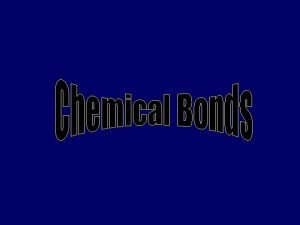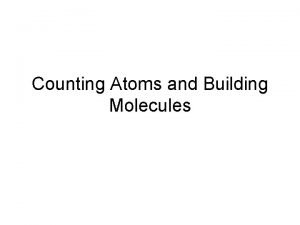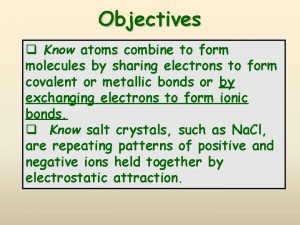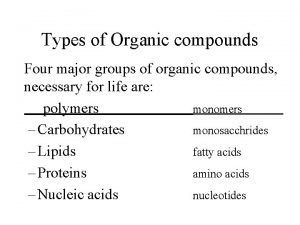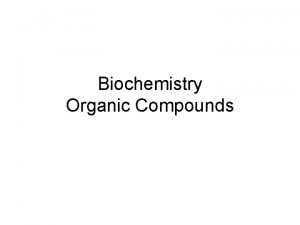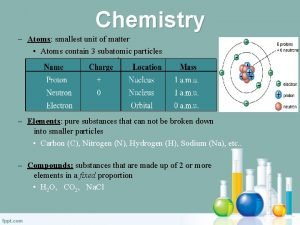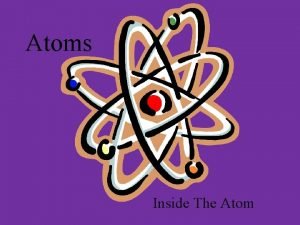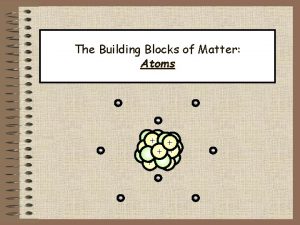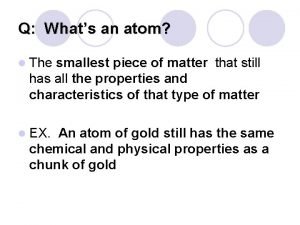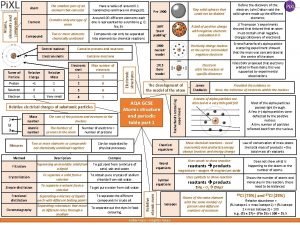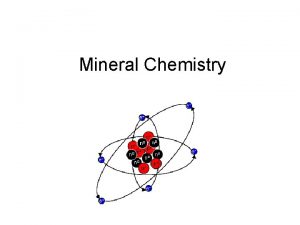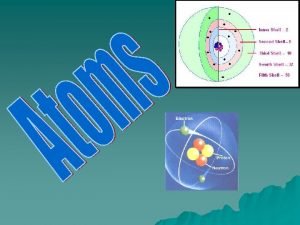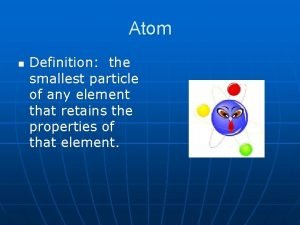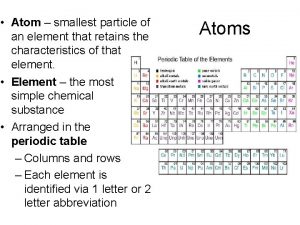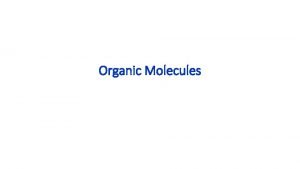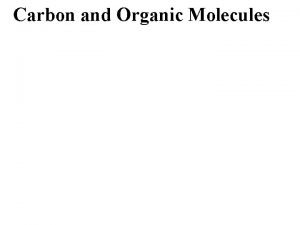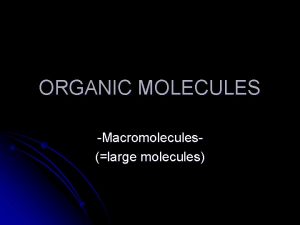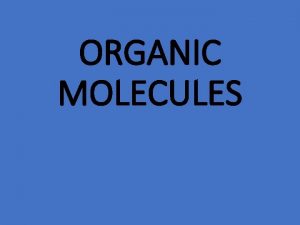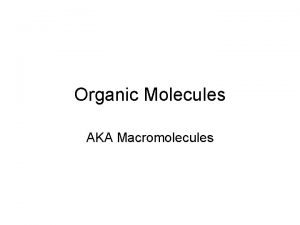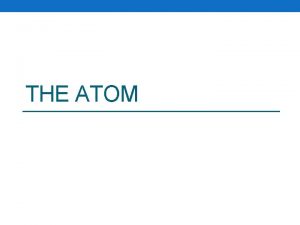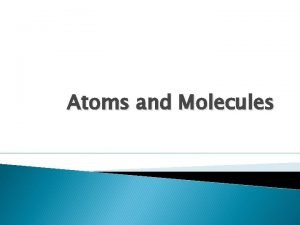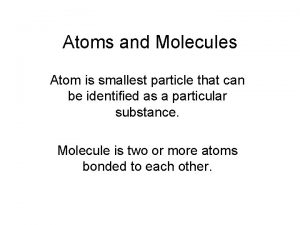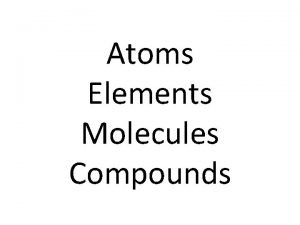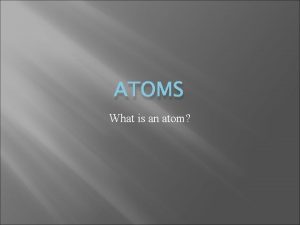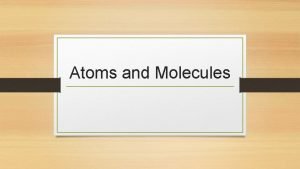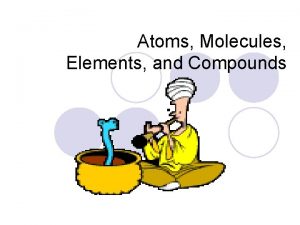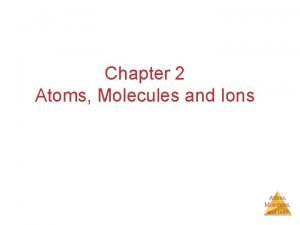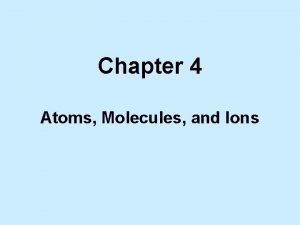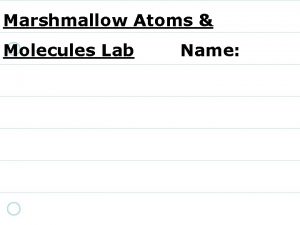Organic Molecules Atoms Identify an Element Atom smallest





























- Slides: 29

Organic Molecules

Atoms Identify an Element • Atom - smallest particle of an element • basic building blocks molecules Negative

What’s an organic molecule? ? • Molecules made up of carbon atoms !!!!!

Carbon – The Atom of All Organisms • Carbon atoms are unique in that they can bond together and create large polymers or macromolecules Single Bond- Double Bond Triple Bond

What’s a polymer? Polymers – Many Monomers A monomer is a single unit such as this link in the entire chain.

Now, we will look at a few organic molecules and their functions • • Carbohydrates Lipids Nucleic Acids Proteins

Carbohydrates – C, H and O

• Glucose and fructose are simple sugars called a monosaccharide – Both have the chemical formula C 6 H 12 O 6 • A disaccharide, such as sucrose, contain 2 sugar monomers and a polysaccharide contain numerous……. Below is the polymer starch which is also a polysaccharide! What is the monomer? ?

Starch is a chain of hundreds of glucose monomers bonded together…. . Grains (wheat, rice, corn, oats, barley) as well as tubers such as potatoes are rich in starch.

Glycogen in Animals **A branched polymer made up of numerous glucose monomers ** Stored in the Liver and muscle of mammals **Long-term energy storage ** Quickly broken down into glucose for immediate energy

Cellulose - Storage in Plants ** Polymer of Glucose ** Stored in Plant cells walls **Offers the plant support ** Energy storage ** Makes up cell wall ** Food source for seeds and plant bulbs

The differences in structures of carbohydrates – but remember all are glucose polymers!!!

Lipids – C, H very little O

Fats Only Carbon-Carbon single Bonds Has Carbon-Carbon double Bonds

Remember the cell membrane? v Phospholipid bilayer!!! v Semi-permeable, allowing only certain molecules to diffuse across the membrane to enter or exit the cell.

Steroids • One example is cholesterol • Most of the cholesterol in our bodies is produced in the liver, though some of it comes from the foods we eat. • The body needs some cholesterol • important to the body's cell membranes • the production of certain hormones • helps act as insulation for your nerves.

Proteins – C, H, O, N sometimes sulfur

** The basic building blocks of proteins are called amino acids. **Remember protein synthesis? ? **A peptide bonds amino acids together **Creates a polypeptide

Insulin • Chemical signaler protein produced in the pancreas • Causes cells in the liver, muscle, and fat tissue to take up glucose from blood and convert it to glycogen that can be stored in the liver and muscles • Diabetes is a condition when a person has high blood glucose (blood sugar), either because insulin production is inadequate, or because the body's cells do not respond properly to insulin, or both.

Hemoglobin • A protein in red blood cells that carries oxygen

Enzymes • Speed up the rate of a chemical reaction (a catalyst) by lowering the energy needed to begin the reaction (Below) • Re-usable • Molecule specific – like a lock and key • -Example: ONLY Lactase will break down lactose. It will NEVER break down proteins

Which substrate can be reduced by the enzyme? ? Specific Enzyme Starch Protein Active Site Simple useable sugars (product) Lipid ***** Enzymes are substrate-specific !!!!!

Enzymes are affected by:

p. H Affects Enzyme Reactivity Rate of Reaction This enzyme functions in an environment that has a p. H of about 4, which is acidic 1 2 3 4 5 p. H scale 6 7 8 9

Nucleic Acids – A Polymer of Nucleotides

Nucleic Acids (DNA, RNA) are Made up of monomers or subunits called nucleotides

RNA § Single. Stranded § Nitrogen bases Adenine (A), Cytosine (C), Guanine (G), Uracil (U) § Remember NO Thymine (T) § Ribose sugar DNA § Double. Stranded double helix § Nitrogen bases Adenine (A), Cytosine (C), Guanine (G), Thymine (T) § Remember NO Uracil (U) § Deoxy-ribose sugar

Remember How These Molecules are Involved in Protein Synthesis? ?

Your Turn…. • Complete the table of organic molecules • Use the handout and this Power. Point to guide you • Cut out the illustrations and paste them in the appropriate place!
 Organic molecules vs inorganic molecules
Organic molecules vs inorganic molecules Smallest unit of energy
Smallest unit of energy Relationship between atoms and molecules
Relationship between atoms and molecules Atoms elements molecules and compounds worksheet
Atoms elements molecules and compounds worksheet How can you count atoms and molecules
How can you count atoms and molecules Atoms molecules and ions
Atoms molecules and ions Atoms molecules and ions
Atoms molecules and ions Atoms molecules and ions
Atoms molecules and ions Atoms molecules and ions
Atoms molecules and ions Atoms ions and molecules
Atoms ions and molecules Atoms ions and molecules
Atoms ions and molecules Atoms combine to form
Atoms combine to form Collision theory states that
Collision theory states that Chapter 2 atoms molecules and ions
Chapter 2 atoms molecules and ions The four major groups of organic compounds are
The four major groups of organic compounds are Organic vs inorganic
Organic vs inorganic Are unsaturated fats solid at room temperature
Are unsaturated fats solid at room temperature Regents periodic table
Regents periodic table Are atoms the smallest unit of matter
Are atoms the smallest unit of matter Smallest atoms in periodic table
Smallest atoms in periodic table Smallest building blocks of matter
Smallest building blocks of matter Quantum mechanical model
Quantum mechanical model Electrons in atoms section 2 quantum theory and the atom
Electrons in atoms section 2 quantum theory and the atom What's the smallest piece of an element
What's the smallest piece of an element Smallest part of an element
Smallest part of an element Whats the smallest particle of matter
Whats the smallest particle of matter What is the smallest part of an element
What is the smallest part of an element Atoms are small hard particles
Atoms are small hard particles Atom adalah bagian terkecil dari suatu
Atom adalah bagian terkecil dari suatu Whats the smallest particle of an element
Whats the smallest particle of an element

